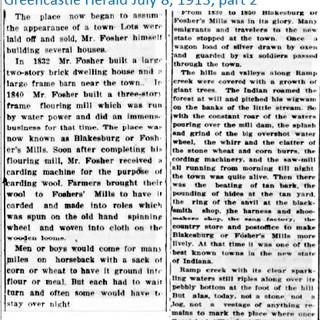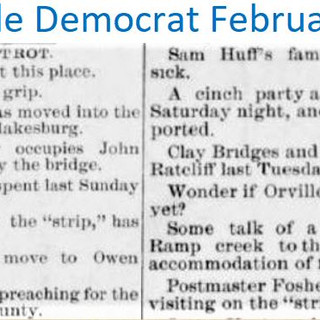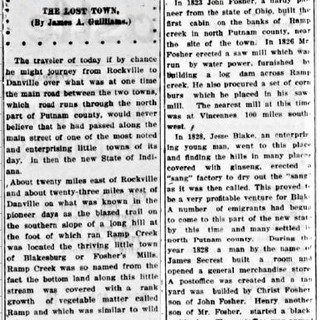Blakesburg
- Larry Tippin, County Historian
- Jul 29, 2019
- 5 min read
Updated: May 4, 2021
Located in southeastern Russell Township, Blakesburg was one of the first settled communities in Putnam County. It had the second post office in the county, after Greencastle and was on one of the early tavern roads, which connected the taverns, or inns, of the communities. A history of Blakesburg by John Guilliams reported in the July 8, 1913 edition of the Greencastle Herald noted that the main road between Danville and Rockville in the early days passed through Blakesburg.
One of the first non-natives to come to the area that would become Blakesburg was John Fosher. His father, Daniel Fosher, had come to America as an aide to his older brother, who was a Hessian hired by the English in fighting the Colonies during the Revolutionary War. He was with the British and Hessian encampment when Washington crossed the Delaware River on Christmas Eve, 1776, capturing those forces. The Hessians who were captured were offered the choice of imprisonment or their freedom if they joined the Continental forces. Being soldiers of fortune with no real allegiance to any of the combatants, it was an easy choice for many of them, including Daniel, to join with the Continentals.
At the end of the Revolutionary War, Daniel Fosher settled in Campbell County, Virginia, where he married Mavillis Echols. Daniel Fosher is buried in a family cemetery south of Centerville, Indiana. The inscription on his stone reads:
“Daniel Fosher, M. D., a soldier of the Revolution. Died August 4, 1849, at the age of 87 years, 2 months and 23 days.”
John Fosher was the eldest of ten children of Daniel Fosher. He married Elizabeth Landis, daughter of Samuel Landis, on December 22, 1804. Three years later they moved to the new State of Ohio to be able to raise their children in a “free” state. He continued to live in Ohio for about 15 years. Hearing of good land in the new state of Indiana, John Fosher explored the area in 1820 with a few others. They came to Terre Haute, then went up the Wabash River and Raccoon Creek and then to Ramp Creek. After planting some peach seeds that he had carried with him, Fosher and his companions returned to Ohio. Fosher convinced his reluctant wife to move to Indiana where he first entered land in 1821, noting the peach seeds he had planted on his previous trip had now sprouted. Fosher then erected what is believed to be the first cabin built along Ramp Creek.
There were few neighbors, except Indians, who were friendly. Marion Borden tells a story that one day an old Squaw came to Fosher’s house with her little papoose strapped to a piece of board and carried on her back. Fosher pointed to the little Papoose and says, ‘what will you take for your little Papoose.’ The Squaw pointed to Fosher’s little son and says, ‘what will you take for your little Papoose.’
In 1826, John Fosher erected a sawmill, run by waterpower of Ramp Creek; he next procured a set of corn-burrs and placed in the sawmill. The nearest grist mill at that time was at Vincennes, about a hundred miles to the southwest. Early accounts referred to the area as “Fosher’s Mill” before it became Blakesburg. In 1832, his oldest son, Christian Fosher, opened the first tan-yard in the area.
James Secrest entered 80 acres in the west ½ of the northeast ¼ of Section 23 of Russell Township and built the first store or trading post in the area. He became the 1st postmaster of Blakesburg on May 26, 1828, which was not yet platted. Later postmasters of Blakesburg were: Abram Poteet, November 11, 1833; Benj. J. Cunningham, March 12, 1834; John Fosher, December 31, 1835; Everett L. Todd, December 18, 1837. The post office was discontinued on October 19, 1839.
In October of 1828 James Blake entered 80 acres in Section 24 adjacent to the Fosher land. Blake was born in Adams County, Pennsylvania, on March 3, 1791 and served in the War of 1812. He settled in Indianapolis in July of 1821, influenced by abundance of ginseng or “sang.” He then established a drying plant at Blakesburg, a second at Indianapolis, and yet a third plant at Delphi. Farmers brought the sang to Nicholas McCarthy’s branch store in Indianapolis where he collected it and shipped to Madison and Cincinnati on its way to China.
James Blake platted “Blakes Burgh” on July 28, 1830 in sections 24 and 25. James Blake died on Thanksgiving Day, November 26, 1870. His name is memorialized by Blake Street in Indianapolis, which is a few blocks west of the downtown area near White River.
In 1832, John Fosher built a large brick home, a two-story dwelling with an attic in which he kept beehives. Stains from the dripping of the honey were to cause wild tales of a murder having been committed in this house. As a child Marion Borden heard these stories on different occasions but her grandmother, whose mother was a granddaughter of Mr. Fosher, told her there was no truth to such tales.
A brother, Jesse Blake, came to this area and entered an eighty-acre tract in August of 1830 and another eighty-acre tract in May of 1831. For a number of years, he operated a store at Blakesburg. His account ledger still survives. It is interesting to note in scanning this book, the manner in which Mr. Blake designated where to find the debtor, many times referring to the fact the customer lived near a certain mill, waterway or with some family. He also noted the type of goods purchased and the ultimate payment. In this book, there is an entry dated September 30, 1830 from a “General Jackson of Washington City” who purchased what appeared to be tobacco, of which no payment was ever received. A review of contemporaneous newspapers and other sources from that era indicates that “Washington City” does refer to Washington D. C., leading one to conclude that the General Jackson noted in the Blake’s account book would likely have been then-president Andrew Jackson, who served from 1829 to 1837 and preferred the term General rather than President.
Charles Boles Bridges came from Montgomery County, near Mt. Sterling, Kentucky, to Indiana in September of 1834, settling first near Parkersburg. He then bought the James Secrest farm of 160 acres near Blakesburg. A biographical sketch of Charles Boles Bridges can be found on page 723 of Weiks 1910 History of Putnam County.
All that remains today of this vibrant early community is the pioneer cemetery on what was John Fosher’s land and to the west of that the foundation of what was the hotel serving Blakesburg.
Some information was obtained by transcripts of a speech given December 6, 1972 by Marion Borden, three times great-granddaughter of John Fosher.
Thanks are also extended to Sara Bridges and Lora Scott for information and photographs.
Be sure to check out Malcolm Romine’s book on Blakesburg and Fincastle at the Putnam County Museum.
















































